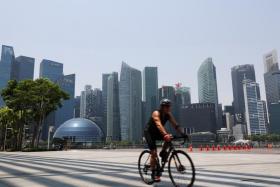Good start to 2017, but dark clouds hover
Though S'pore's 1.8 per cent growth in Q4 beat estimates, it is lowest since 2009
As we embark on 2017, the Singapore economy has just delivered a nice new year present.
Its 1.8 per cent year-on-year growth in the fourth quarter (based on advance estimates), beat about every economist's forecast and demolished some, including the measly 0.6 per cent by Reuters, based on a poll.
Full-year growth for 2016 - also 1.8 per cent - was another upside surprise, besting the Government's own forecast of 1 per cent to 1.5 per cent and again, ahead of the consensus.
But cheering for 1.8 per cent growth is being grateful for small mercies. While it is better than expected, it is still the lowest growth number since 2009's recession.
Moreover, there are legitimate doubts that even this relatively modest level can be sustained, let alone bettered, in the years ahead.
For one thing, much of the growth last year was manufacturing-driven. The manufacturing sector was the star of the fourth quarter, expanding by 6.5 per cent over the same period the previous year.
However, the expansion within manufacturing was not broad-based, being concentrated in just two clusters - electronics and biomedical.
VOLATILE
Other manufacturing clusters showed negative growth. Manufacturing is notoriously volatile. The sector contracted in three of the last six quarters. This would not be so bad for overall growth if the other sectors were doing well, but they are not.
The services sector grew just 0.9 per cent last year, while construction eked out 1.3 per cent growth.
Barring policy surprises, there is little prospect of services or construction turning buoyant in 2017. So we must still rely on volatile manufacturing.
That said, we cannot rule out the possibility that it will have another decent year.
If US President-elect Donald Trump delivers on his pro-growth agenda, if his administration refrains from putting protectionist policies in place, if China can contain its economic slowdown and if Asean economies continue growing, the Singapore economy - and manufacturing - stands a chance of at least matching last year's performance.
But if some or all of the above do not happen, that bet is off.
GLOOM
Adding to the gloom would be a cycle of rising US interest rates, which has already started, and could be prolonged, especially if a Trump administration goes for high growth amid low unemployment, which could raise inflation fears at the US Federal Reserve.
In Singapore's domestic economy, there continue to be sectors suffering from weakness, particularly oil and gas, retail and property. The latter two could be further hit by tepid private consumption as well as disruption from e-commerce - which is set to make more inroads with the growing presence of Amazon and Alibaba.
What are the options for policy? The big near-term event on the policy calendar is the release of the report of the Committee on the Future Economy (CFE) this month.
This is likely to contain recommendations for longer-term restructuring - which will be vital to spur innovation and growth, but will have little short-term impact.
We must look to the budget. While external demand is out of policymakers' control, there is limited scope to boost domestic demand.
But Singapore's fiscal space is narrowing. As Finance Minister Heng Swee Keat cautioned last year, "the longer term picture will grow more challenging as we expect expenditure needs to grow faster than revenues".
It is unrealistic to expect the minister to come up with a fiscal boost in the form of handouts whenever growth is sub-par.
What needs boosting are the engines of the economy, and this needs more work on the supply side. Three areas need special attention. One is business costs, which are still too high for too many SMEs in particular.
Another is access to skills - especially those vital to build an innovation-driven economy. While upgrading local skills deserves emphasis, this will bear fruit over the medium term.
For the short term - the next three years at least - Singapore must ease companies' access to foreign skills which could be a reason for the slow growth.
AGGRESSIVE
A third area is more aggressive policies to incentivise companies to internationalise, especially within fast-growing Asean.
Finally on trade: Under the incoming Trump administration in the US, the Trans-Pacific Partnership - which once held out the promise of expanded commerce in our region - can be counted as dead in the water or at best, in deep cold storage.
Fortunately, Singapore had the foresight to negotiate a network of 21 free-trade and economic partnership agreements.
There is one more trade agreement on which negotiations will hopefully start, and soon. That is with the UK, which is set to leave the European Union and will no longer be covered by the EU's trade agreements.
The UK is about to start negotiating its own network of free trade agreements (FTA).
Given that Singapore is its biggest trading partner in South-east Asia with the largest number of British companies in the region, a UK-Singapore FTA should be high on London's priority list.
And as the UK is Singapore's largest market and biggest investment destination in Europe, such an agreement should be high on our list too. This is another space to watch in 2017.
This article appeared in The Business Times yesterday.
Get The New Paper on your phone with the free TNP app. Download from the Apple App Store or Google Play Store now


